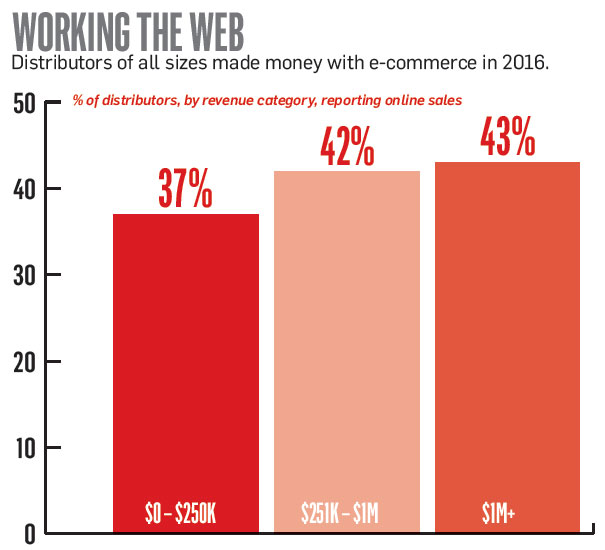July 19, 2017
The Age of E-Commerce Is Here
Firms that ignore e-commerce shifts risk becoming obsolete in the future.
In the promo products market, the age of e-commerce is officially here. State of the Industry data shows four in 10 distributors now say they’re generating business from online sources – be it a direct sale or the beginning of a transaction. Within those companies, an average of 18% of their sales came from e-commerce in 2016. The larger the distributor, the more likely the firm has some amount of e-commerce business.
>>Back to the State of the Industry 2017
One company leading the e-commerce charge is DiscountMugs.com (asi/181120) – a firm that operates 100% online. The societal shift to e-commerce has been a boon to the Florida-based firm’s business – which grew sales 19% last year, reaching $198 million.
“We have always been an e-commerce firm, so the shift has worked in our favor,” says Sai Koppaka, president of BEL USA, whose brands include DiscountMugs. “However, the best ROI has always been our investment in user experience to make the purchase process very simple and intuitive. Also, by being rooted in e-commerce, we measure everything we do and continually optimize to maximize ROI.”

According to Matthew Iovanni, CEO at Full Funnel, a sales and marketing consultancy, there’s no such thing as a quick move to e-commerce for traditional firms. While websites are on the top five list of lead-generation strategies, it does take some work to get sites seen by customers.
“You need to have organic traffic and attract people who are searching through the web,” Iovanni says. “In order to do that, you have to do a lot of inbound marketing: blogging, e-books, etc. It takes time and a lot of content. There’s an up-front cost, but it’s evergreen; people will find you in perpetuity.”
What does that practically mean for most distributors? If you want to compete in the digital space, you need to develop a forward-looking plan right now. The reality is the world of e-commerce isn’t going away. In fact, it’s poised to only get larger as time goes on. And while more promo firms are leveraging online channels for sales, 46% of distributors see websites that sell logoed items as the top threat they face.
It’s a challenge that distributors can’t ignore, and should face with a smart, service-focused approach. “If a distributor offers significant additional value in working with customers to design campaigns and source unique products, they will be OK in the short term,” Koppaka says. “There will always be customers that require in-depth personal assistance throughout the process, but that trend is shifting. More and more customers are turning to the web to research and purchase products. More and more customers are comfortable ordering online.”
However, he adds, “If a distributor offers no significant value in addition to selling simple printed commodity promo items, then they are at significant risk of losing business to web-based firms.”
Koppaka expects promotional products industry trends to mirror those of the retail space. Competition from sites like Amazon, he says, is driving out larger companies like Sears and JC Penney, because they aren’t up to par on offering an easy-to-use online purchasing system like what the market has come to expect.

But Koppaka also notes that if distributors are willing to adapt, they’ll see the shift to e-commerce as a tremendous opportunity for growth, rather than the nuisance it may seem like today.
One thought: Instead of changing up their entire business model initially, distributors can gradually offer more products for purchase online, possibly geared toward specific market niches or based around holidays like the Fourth of July. If a site’s SEO is good enough, the page will generate views. Once a prospect starts scrolling through, a box can pop up with off-line contact info for human, one-on-one help. It’s a way to differentiate a site from simply being a click-and-buy experience.
“We are focused on improving customer relevance and better personalizing the experience,” Koppaka says. “We carry thousands of products, so it is critical that we help customers find the exact item for their specific need and budget. Technology will allow us to better recommend products and even predict customer needs in advance.”
And as this world of internet-based sales continues to take hold, Koppaka has one closing thought for distributors everywhere: Get ready and go for it, because the shift is already here. “If we don’t adapt to changes in customer preference, we risk obsolescence very quickly,” he says. “We see an acceleration in the shift toward online purchases, and the sooner our industry adapts, the better it is for everyone.”